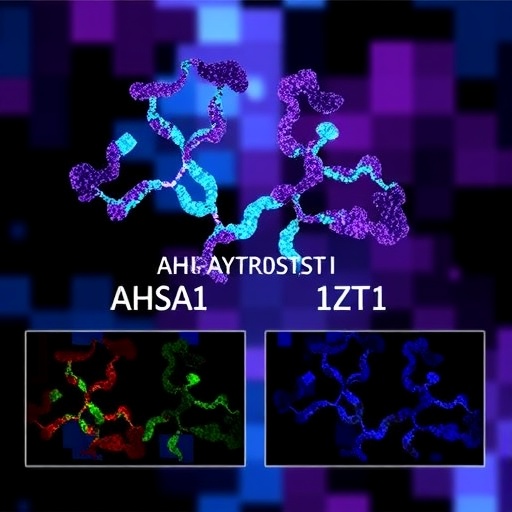In a groundbreaking study recently published in BMC Cancer, scientists have unveiled pivotal insights into the role of the heat shock 90 kDa protein ATPase homolog 1 (AHSA1) in head and neck squamous cell carcinoma (HNSCC). This research highlights AHSA1 not only as a significant prognostic biomarker but also as a viable target for immunotherapy, potentially transforming approaches to treat this aggressive form of cancer.
AHSA1 is a well-known co-chaperone of heat shock protein 90 (Hsp90), a molecular chaperone implicated in the stabilization and function of numerous oncogenic client proteins. Prior studies have identified AHSA1’s overexpression in various cancers, facilitating processes such as tumor cell proliferation, migration, and invasion. However, its exact contribution within the HNSCC tumor microenvironment had remained obscure until now.
Employing a multifaceted integrative analysis that combined bulk RNA sequencing with single-cell RNA sequencing (scRNA-seq), the research team conducted a comprehensive investigation into AHSA1 expression and functionality in HNSCC. This approach allowed them to dissect gene expression profiles at both the population and individual cellular levels, lending unprecedented resolution to the biological narrative underlying tumor progression.
Their data revealed that AHSA1 expression is markedly elevated in HNSCC tumors compared to normal tissues. Notably, this overexpression correlated strongly with critical clinicopathological parameters including disease stage advancement, TP53 mutation status, and human papillomavirus (HPV) infection—factors already known to influence prognosis and therapeutic outcomes in HNSCC patients.
Survival analyses employing Cox regression models and Kaplan-Meier survival curves established AHSA1 expression as an independent prognostic biomarker. High levels of AHSA1 expression were significantly associated with poorer overall survival rates, underscoring its potential utility in stratifying patients for tailored treatment regimens.
Beyond prognostic implications, the research delved into the tumor immune microenvironment to elucidate AHSA1’s role in modulating immune cell infiltration. Intriguingly, an inverse relationship surfaced wherein increased AHSA1 expression coincided with reduced populations of tumor-infiltrating immune cells. This depletion suggests that AHSA1 may contribute to immune evasion mechanisms, thereby offering a potential explanation for resistance observed in certain immunotherapy-responsive patients.
Expanding the therapeutic horizon, the study evaluated correlations between AHSA1 expression and chemosensitivity. Tumors exhibiting higher AHSA1 levels demonstrated enhanced responsiveness to multiple chemotherapeutic agents, implying that AHSA1 status might guide precision medicine strategies by predicting drug efficacy and improving treatment personalization.
To substantiate these bioinformatics findings, the investigators conducted rigorous experimental validations, both in vitro and in vivo. Silencing AHSA1 expression via molecular techniques significantly attenuated cellular proliferation, migration, and invasive capabilities in cultured HNSCC cell lines. Consistently, AHSA1 knockdown in mouse models led to marked suppression of tumor growth, spotlighting AHSA1 as a compelling therapeutic target.
The integration of scRNA-seq data further illuminated the functional landscape of AHSA1 within HNSCC tumors. This high-resolution analysis provided insights into cellular heterogeneity and pinpointed specific cell populations where AHSA1 exerts maximal influence, thereby refining our understanding of its role in cancer pathobiology.
Collectively, these findings position AHSA1 at the nexus of tumor progression and immune modulation in HNSCC. Its dual functionality as a biomarker and therapeutic target opens avenues for novel immunotherapeutic interventions that may enhance patient outcomes.
Moreover, targeting AHSA1 could disrupt tumor cell survival pathways and restore immune surveillance, offering a two-pronged attack against tumor growth and metastasis. This therapeutic potential is particularly compelling given the limited efficacy of current treatment options for advanced HNSCC cases.
With robust experimental evidence affirming the oncogenic role of AHSA1, future clinical trials investigating AHSA1 inhibitors or related immunotherapeutic agents could revolutionize the management of HNSCC, transforming it from a largely incurable malignancy to a controllable disease.
In summary, this landmark study underscores AHSA1’s multifaceted role as a biomarker predictive of prognosis and a functional node influencing immune microenvironment and therapeutic response. It heralds a promising new chapter in the quest for targeted therapies against head and neck cancers, where precision oncology and immunotherapy converge.
As the scientific community continues to unravel complexities inherent in HNSCC, integrating multi-omic data and translational research will be key to translating these molecular insights into clinical breakthroughs. AHSA1 stands out as a beacon guiding this precision-driven future.
The discovery not only enriches our molecular understanding of HNSCC pathogenesis but also offers tangible hope for patients confronting this challenging diagnosis, signaling a paradigm shift in personalized cancer therapy.
Subject of Research: Role of AHSA1 in head and neck squamous cell carcinoma (HNSCC), its prognostic value, immune microenvironment interactions, and therapeutic potential.
Article Title: AHSA1 as a prognostic biomarker and potential immunotherapeutic target in HNSCC: integrative bulk RNA-seq, scRNA-seq analyses and experimental validation
Article References:
Gu, F., Wu, E., Yan, X. et al. AHSA1 as a prognostic biomarker and potential immunotherapeutic target in HNSCC: integrative bulk RNA-seq, scRNA-seq analyses and experimental validation. BMC Cancer 25, 1560 (2025). https://doi.org/10.1186/s12885-025-14833-2
Image Credits: Scienmag.com




